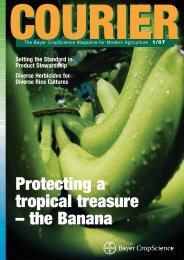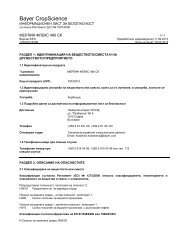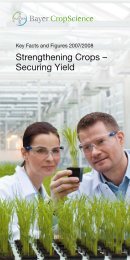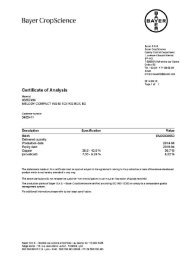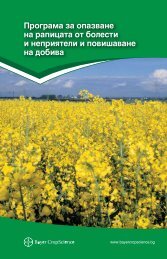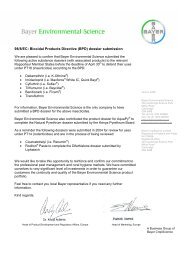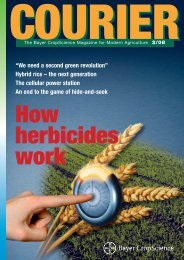Potatoes⦠- Bayer CropScience
Potatoes⦠- Bayer CropScience
Potatoes⦠- Bayer CropScience
You also want an ePaper? Increase the reach of your titles
YUMPU automatically turns print PDFs into web optimized ePapers that Google loves.
as far back as 7,000 years ago, when they<br />
were found growing wild in the vicinity of<br />
Lake Titicaca.<br />
With the sole origin of the potato having<br />
been scientifically determined, studies of<br />
its spread to other countries are also of<br />
some interest. It was being grown in Peru<br />
by around the 8th century BC and, according<br />
to chronicler Pedro Cieza de León, a<br />
contemporary of explorer Francisco<br />
Pizarro, the potato was taken to Spain<br />
in 1554 from where it spread throughout<br />
Europe. It reached India in 1610 and<br />
China in 1700.<br />
Worldwide importance<br />
As specified by the FAO, potatoes are of<br />
decisive importance in the diets of hundreds<br />
of millions of people worldwide, and<br />
The potato, with its many different varieties, is a basic<br />
food crop for people in the Peruvian Andes. Peru is<br />
the country in which the genetic diversity of potato<br />
varieties is greatest.<br />
Left: harvesting native potatoes at 4,000 metres<br />
above sea level.<br />
their annual consumption has increased<br />
from under 10 kg per capita in the early<br />
sixties to 21 kg today.<br />
Annual potato production is currently<br />
over 300 million tonnes and billions of<br />
people over the world consume this much<br />
appreciated tuber from the Peruvian<br />
Andes. In this regard, the FAO maintains<br />
that, since the early 60s, the surface area<br />
taken up by potato crops in the developing<br />
world, particularly China and India, has<br />
exceeded that of all other basic foodstuffs,<br />
with the demand in 2020 expected to be<br />
double that of 1993.<br />
Indeed, nowadays there are no countries<br />
where potatoes are not grown. China,<br />
Russia, India, the United States, Ukraine,<br />
Poland and Germany are the leading<br />
producers.<br />
However, although potatoes have played<br />
a fundamental role in relieving hunger on<br />
the planet, they have also been the cause of<br />
famines. From 1845 to 1848, four million<br />
people in Ireland died from hunger and<br />
malnutrition because of Phytophthora<br />
infestans, a terrible disease known as<br />
potato blight, which destroyed all the<br />
country’s crops.<br />
Hub of the potato universe<br />
Peru grows eight native potato species and<br />
2,300 of the nearly 5,000 current potato<br />
varieties. It is also home to 90 of the 200<br />
wild species growing on the American<br />
continent, making it the country with the<br />
greatest potato diversity in the world.<br />
The commercial varieties of potato found<br />
in Peru have curious names: Tomasa,<br />
Canchán, Amarilla, Colorada, Criolla,<br />
Tarmeña, Huamantanga, Peruanita, Perricholi,<br />
etc.<br />
One thing is clear: the potato, with all<br />
its different varieties, is a fundamental food<br />
crop for people in the Peruvian Andes.<br />
The potato is so important for feeding<br />
the world, that the United Nations General<br />
Assembly has declared 2008 the “Inter -<br />
national Year of the Potato”, justly<br />
acknowledging a crop which, although of<br />
local Andean origin and nature, is now part<br />
of our food heritage on a universal scale.<br />
This is the perfect occasion for attention<br />
to be paid to the potato by governments<br />
and the authorities involved in world food<br />
security and for Peru, as its source of<br />
origin, to assume leadership in fostering<br />
its worldwide growth and consumption.<br />
Indeed, the efforts made to promote the<br />
implantation and productivity of this crop,<br />
together with its post-harvesting management<br />
and consumption, will be most<br />
welcome.<br />
In this regard, Peru is privileged to<br />
house the headquarters of the International<br />
Potato Centre, the home of the most comprehensive<br />
genetic bank in the world,<br />
where highly qualified scientists from<br />
Asia, Africa, Europe, America and<br />
Oceania dedicate their lives to investigating<br />
production systems, natural resource<br />
management and crop and genetic resource<br />
enhancement and to preserving and<br />
protecting genetic material related to the<br />
potato and other tubers.<br />
Equally important is the research conducted<br />
at the centre relating to pests and<br />
diseases, use and processing methods, seed<br />
production and potato-related statistics.<br />
A Peruvian project, T´ikapapa, recently<br />
won the first prize in The World Challenge<br />
2007 competition from among 940 other<br />
projects. The contest, sponsored by the<br />
BBC and Newsweek magazine, seeks out<br />
development projects and businesses that<br />
not only make a profit but also put something<br />
back into the community. Making a<br />
difference through enterprise and innovation<br />
at a grass roots level is also a key<br />
requirement.<br />
T´ikapapa is a social marketing concept<br />
enabling resource-poor farmers from the<br />
Peruvian Andes to market their distinctly<br />
labelled native potato crops in Lima’s<br />
supermarkets.<br />
<strong>Bayer</strong> <strong>CropScience</strong> in Peru<br />
<strong>Bayer</strong> <strong>CropScience</strong> has been supporting<br />
these century-old crops in Peru for many<br />
years, with a broad range of high quality<br />
products including fungicides such as<br />
Antracol ® and Fitoraz ® , insecticides such<br />
as Regent ® , Bulldock ® and Alsystin ® and<br />
herbicides such as Sencor ® .<br />
Launches of new solutions are also<br />
being prepared for the future, including a<br />
new portfolio for controlling potato blight<br />
with fungicides such as Sectin ® /Sereno ® ,<br />
Consento ® , Infinito ® and Trivia ® .<br />
All these products also form part of a<br />
campaign to teach farmers how to safely<br />
manage and use crop protection products,<br />
together with application techniques. Run<br />
through the Agrovida ® programme and<br />
Integrated Crop Management at farming<br />
schools, it ensures healthy crops with eco -<br />
nomic profits.<br />
We are faced, then, with a fact and an<br />
opportunity. The fact is the ancestral origin<br />
of the potato, its diversity and its universal<br />
importance. And the opportunity to reinforce<br />
its importance as a foodstuff, enhance<br />
its production and increase its consumption<br />
is provided by the “Inter national Year<br />
of the Potato”. ■<br />
Written by:<br />
Fernando Cillóniz Benavides,<br />
Manuel A. Cueva, Javier A. Chávarro<br />
1/08 COURIER 27





